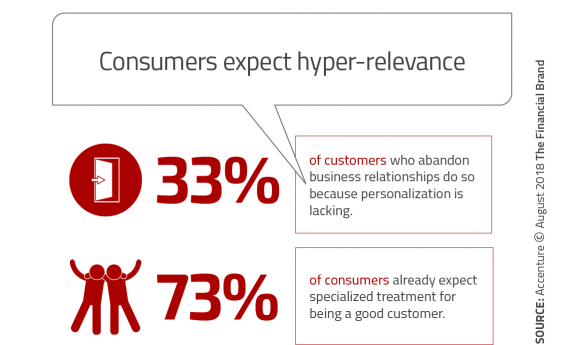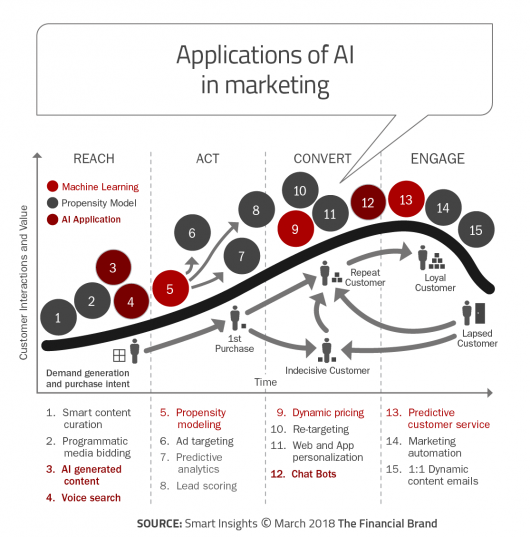How was your first full work week of the new year? We hope it was a smooth start and that you are ready to be on the top of your game.
Last week, we analysed the most-mentioned six fintech predictions for 2019. Today, we have a look at marketing trends, especially in financial services. It is essential to look ahead to what the marketing industry offers to seek out new opportunities to engage your audience. To help, here are five marketing trends that will play an important role in 2019:
- Data-driven marketing insights
- Personalisation
- Content
- Technology-powered marketing tools (AI, Chatbots, Voice search
- Mobile-first marketing
1. Data-driven marketing insights
There has been a transformation in the way marketing looks like in the digitalised age. This year, we expect to see an increase in data-driven marketing in the financial services sectors. Data is strategically crucial for any marketer to monitor customer engagement. The insight data give helps to communicate and sell their products and services in a customer-centric way.
Financial services companies already have a lot of the information on their audience. To develop truly great marketing they need to transform this information into actionable insights. This will demonstrate your company’s expertise to drive your marketing efforts.
2. Personalisation
If you’re communicating with your audience with generic messages, keep in mind that it will not work in 2019. Personalisation and authenticity will separate successful marketers from those who just contribute to the noise. It is vital for financial services to build a seamless experience and offer around the needs of the customer. Providing the right offers to make your audience feel special should be the priority with the data that is available and the technology that can analyse it.
This infographic (The Financial Brand/Accenture) shows that 73% of consumers already expect specialised treatment for being a good customer.

The consumer will control the journey, but also the conversation. It is time for financial services to step up their game to engage and serve their audience better. So please, don’t send your audience a generic, product-centric marketing message and irrelevant content. Be authentic, and focus on customer-centric marketing.
3. Content is the core
Content plays a significant role for many companies to earn the audience’s trust, build their brand, generate website traffic and find qualified leads. Financial services should use content optimally by having a content strategy focused on a consumer reaching financial stability (or more), on building trust, and gaining loyalty.
It comes back to personalisation. By having the available data from your audience, using technology to analyse it, and providing relevant content, this will increasingly be the way to have better engagement with your current and potential customers.
4. Technology-powered marketing tools (AI, Chatbots, Voice search)
Artificial intelligence
In 2019, we will see AI-powered marketing attribution tools hitting their stride. It is crucial to offer your audience a more personalised experience based on their needs at the right time. AI can sequence the customer journey together and identify the activity of a customer -- for example when a customer comes to a company’s site and leaves without converting.
The traditional banks are trying to master data-driven marketing through artificial intelligence (AI). However, there are also many startups building this technology to make people’s lives easier. Will we see any collaboration between them? Or do traditional banks think they can do it all themselves?

Chatbots
Chatbots popularity is rising, especially in 2019. Many banks are using chatbots to deal with common questions from their customers. Soon, chatbots will assist customers in carrying out transactions and offering financial advice based on the customers’ situation. It will provide benefits that go beyond customer service.
Fintech startups are developing chatbots to be smarter and more authentic to serve their customers or be incorporated in large financial institutions. It is vital that chatbots have a “personal and human” touch while interacting with the customers. Not only do chatbots interact with your customers but they gives you insight to exactly what your audience members are looking for and when. So, chatbots should be on your radar in 2019 and are worth investigating further.
Voice search
One of the trends is voice search. The use of voice-based search queries will increase in 2019. Almost one-third of the 3.5 billion searches performed on Google every day are voice searches, with personal assistant devices leading the way. Financial services companies should understand the nuances of voice search.
Consumers use a digital assistant to give them only a few results based on their voice search. Therefore, your SEO strategy for voice search is essential and more complicated. Identifying how customers formulate their questions when they 'speak' could optimise your company’s search-result performance. It is an opportunity for fintech startups to develop technology in the voice search area. They could build their products to help customers access their financial information and use voice search assistant to get financial products.
5. Mobile-first marketing
More and more people are performing search on their mobile phones. Especially, people are accessing their financial accounts via mobile devices. With more than 50% of customers that use mobile first, your website or platform better be mobile friendly.
In 2019, providing content to mobile users is crucial. It is important to have the right mobile strategy from simply providing account information, engaging and advising on-the-go users. Make sure it is easy for the consumer to get the information with designs that look good on a mobile and information that can easily be digested on the go.
Ready for 2019!
Given these 5 trends, there should be enough reason for financial services and fintech companies to be authentic and focus on customer-centric marketing. There are enough possibilities with the available tools. You don't have to focus on them all at once, but make sure you include the ones that could offer the best experience for your customers in your marketing strategy.
Sources:
